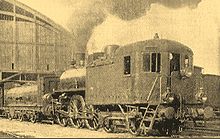Cab-forward locomotive


With cab forward (English as cab front ) are steam locomotives called that, contrary to the conventional construction with the cab ride ahead.
The main advantage of this design is the significantly better view to the front, because the field of vision of the locomotive driver is not restricted by the boiler . The main disadvantage that has prevented this type of construction from becoming more widespread are the problems with the fuel supply.
If you leave the boiler in its usual position, i.e. with the fire box at the rear end, the engine driver and stoker are spatially separated from each other. As a result, they can no longer support each other and only communicate with one another via a mouthpiece . Locomotives of this design were z. E.g. the 2'B3 ' locomotive of the French engineer M. Thuile with 2.50 m large drive wheels and the Prussian test locomotives S 9 (2'B2', see picture) and T 16 (2'C2 'h2t).
The placement of the boiler with the firebox front, so the cab, solves this problem, however, resulting in an ongoing behind the locomotive Tender solid fuel is no longer possible. Because a pushed tender is undesirable for reasons of running safety and also leads to a visual obstruction, the coal supply must either be stored on the locomotive itself, which is only useful up to a certain boiler size due to the limited clearance , or the furnace must be fueled which can be conveyed in pipelines from the tender to the fire box. Coal dust and oil are suitable for this .
The most successful cab-forward locomotives were with cabbage boxes on the locomotive itself, the vehicles of the genus Gr670 and Gr671 the South Adriatic railway in Italy . They had a 2'C wheel arrangement and the tender running behind the locomotive only contained the water supply. The machines were in use from 1900 to the 1940s. The Gr672 was a further development of this design with a Franco-Crosti feed water preheating in the tender.
For the German 05 003 , the solution of a pulverized coal combustion was chosen. But on the long way between the tender and the fire box, the flow of air and coal dust, which was conveyed by a fan, separated itself, so that the dust was not completely burned. The problems finally led to the fact that the locomotive was turned around and converted into a conventional, with the smoke chamber in front and fired with lump coal, analogous to the locomotives 05 001 and 002 , which was planned from the beginning in the event that the tests failed.
In addition to the Italian machines, the most successful cab-forward locomotives, which also coined this designation, were the 244 locomotives of classes AC-1 to AC-8 and AC-10 to AC-12 of the Southern Pacific Railroad . The articulated locomotives with the wheel arrangement 2'D (D1 ') were fired with oil and thus avoided the problems that occurred with the 05 003. The motivation behind the introduction of this design was not the better visibility, but the problem that the crews of the conventional locomotives were so exposed to the smoke of their own locomotives in some long tunnels and avalanche galleries that they had to drive with gas masks. Some locomotive drivers went over to turning their locomotives and driving backwards through the tunnels, from which the idea for the "Cabforwards" arose.
